Suspensions in Colorado schools jump 25% as districts struggle to staff since pandemic
The story was originally published in The Denver Post with support from our 2023 Data Fellowship.

Safety advocate Jaime Ferrer walks the hallways between classes at Adams City High School in Commerce City on Aug. 27, 2024. Adams County School District 14 is employing safety advocates to help foster positive relationships with students while keeping them safe. Ronnie Brickey, the district’s director of safety and security, says the advocates’ primary mission is safety, but they also focus on the mental, social, emotional and physical well-being of the students.
(Photo by Helen H. Richardson/The Denver Post)
Colorado school districts dramatically increased their use of out-of-school suspensions as pandemic-era staffing shortages made it harder to fill positions that play a crucial role in keeping children in classrooms, an analysis of state data by The Denver Post shows.
Statewide, districts removed children from their buildings more frequently after in-person learning resumed as overall suspensions reached their highest point in at least 11 years during the 2023-24 academic year.
The increase was primarily driven by schools’ growing use of out-of-school suspensions, which have jumped 25% since the 2018-19 academic year, according to The Post’s analysis.
In those same six years, staffing shortages in Colorado schools more than doubled, making it difficult for districts to keep their buildings open during the height of the pandemic much less meet the growing mental health needs of children post-lockdown.
“It’s just overwhelming right now; our kids need so much,” said Cassandra “C.J.” Berry, principal of Eastlake High School, an alternative charter school in Colorado Springs. “Going back to suspensions is kind of a knee-jerk reaction.”
The Post analyzed suspension and staffing data from the Colorado Department of Education since the 2018-19 academic year to better understand why use of the disciplinary tool increased in the years after in-person learning resumed. Out-of-school suspensions, primarily issued for nonviolent offenses, increased across the state. But districts in metro Denver removed children from their buildings at a significantly higher rate than those in rural communities as they faced more pronounced support-staff shortages once COVID-19 school closures ended, The Post found.
This story is the first in an ongoing series that will examine school discipline in Colorado since the pandemic, including its impact on students of color and children with disabilities.
Statewide, districts issued 70,597 out-of-school suspensions last year, up from the 56,258 in 2018-19, according to state data.
Even districts such as Denver Public Schools that faced heavy criticism in recent years for being too lenient when disciplining students are removing children from their classrooms more frequently than they did before the pandemic.
At DPS, the state’s largest district, out-of-school suspensions jumped 42%, to a rate of 47 per 1,000 students, in the six-year span examined by The Post.
DPS chief of staff Deborah Staten said the increase in student removals wasn’t the result of any policy change from the district. The state education department changed how it collected discipline data during the 2023-24 academic year, which could partly explain the surge in suspensions, she said.
Staffing shortages, Staten added, also played a role.
“When kids don’t have a trusted adult in the building that they connect with, that’s difficult for them,” she said.
A DPS student named Joey, who The Post is not fully identifying to protect his privacy, has received nine in- and out-of-school suspensions over the past three years. Most were related to the 16-year-old’s marijuana use, which began in eighth grade after in-person learning resumed in 2021.
“It made me feel like I was failing as a student and as a child,” Joey said about the repeated suspensions, adding, “It seems like they don’t really care for students and why they are using.”

Joey, a Denver Public Schools student, speaks about school and his repeated suspensions during an interview in April at Denver Healing Generations, where he was taking part in an after-school group with other students.
(Photo by Helen H. Richardson/The Denver Post)
“We’re punishing them for being human”
Colorado’s youth mental health crisis began even before COVID-19 temporarily closed schools in 2020, as more children and teens reported being anxious and depressed. Suicide had been the leading cause of death for Coloradans under the age of 18 for six years by the time the virus was discovered here.
But as with many things, the pandemic took its toll on adolescents’ mental health and children struggled when they returned to classrooms post-lockdown. They were not only behind academically, but they also had difficulty regulating their emotions and socializing in person once again, according to students, parents, educators and mental health experts.
When schools reopened, districts faced severe staffing shortages that made it difficult to hire enough mental health providers, special education specialists and paraprofessionals, also known as teacher aides. These positions made up almost half of the more than 3,260 staffing shortages reported by Colorado school districts during the 2022-23 and 2023-24 academic years.
As staffing shortages increased, so did out-of-school suspensions, state data shows, which led to more lost class time for children who already had their education interrupted by the worst public health crisis in a century.
Districts with a shortage of either special education specialists or paraprofessionals had about a 40% higher out-of-school suspension rate than districts that fully staffed those positions during the 2022-23 academic year, according to The Post’s analysis.
Unlike previous years, the state’s just-released data for the 2023-24 academic year was heavily redacted at the district level, so as to not risk identifying individual students. The Post was unable to replicate its full analysis for last year.
But data for the five previous years showed that except for the 2020-21 academic year — when most classes were online — school districts with a shortage of special education specialists always had a higher suspension rate compared to those that were fully staffed.
Districts with paraprofessional shortages also always had a higher suspension rate during the four years with available data, according to The Post’s analysis. (The education department did not start collecting data on paraprofessionals until the 2019-20 school year.)
Likewise, districts with a shortage of school psychologists or social workers had a 24% higher out-of-school suspension rate than those that were able to fill such positions — a change from four years earlier, before the pandemic, when districts with such shortages had the same suspension rate as those that were fully staffed, The Post found.
“The pandemic was a profound tragedy and trauma in our society and we’re still trying to manage and heal with that trauma,” said Kevin Vick, president of the Colorado Education Association, the state’s largest teachers union. “We’re having fewer and fewer people in our schools who have the training to work through that.”
Mental health providers, special education specialists and paraprofessionals all work with Colorado’s most vulnerable students: children with disabilities. School psychologists, social workers and paraprofessionals also work with the broader student population.
Adults in all of these positions can build relationships with children that allow them to intervene before a student’s behavior reaches the point where they are suspended, according to educators and advocates who help families navigate discipline proceedings.
But these employees are in high demand, and not just in schools, where their jobs are high-stress and come with heavy caseloads and low pay compared to what they might earn elsewhere, Vick said.
“Given the economic and budget challenge that schools have, it’s tough to hang onto these people when they have such great lucrative opportunities in other areas,” he said
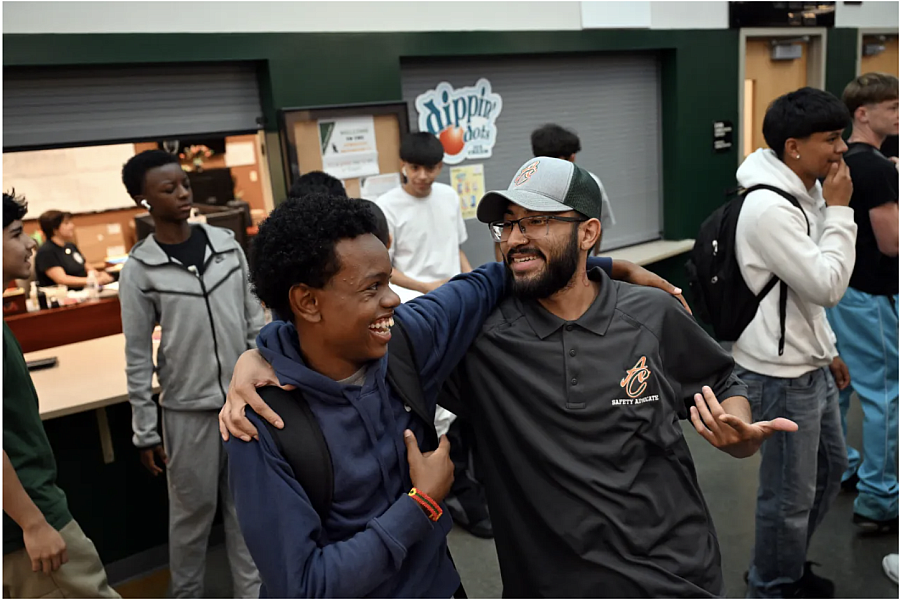
Safety advocate Gio Lopez, right, gets greeted by student Mal Falama, left, in the hallway during a break between classes at Adams City High School in Commerce City on Aug. 27, 2024. The Adams 14 district is using safety advocates to help foster positive relationships with students while keeping them safe.
(Photo by Helen H. Richardson/The Denver Post)
About 90% of the more than 70,500 out-of-school suspensions issued by districts during the 2023-24 academic year were for less severe infractions, such as disobedience, substance use and property destruction — behaviors that advocates and mental health experts said are better handled in schools via counseling or restorative justice practices.
Not only was there less support staff in schools, but the shortages also led to larger class sizes in general, meaning teachers had less time to connect with students and to meet children’s individual needs, said Rob Gould, president of the Denver Classroom Teachers Association.
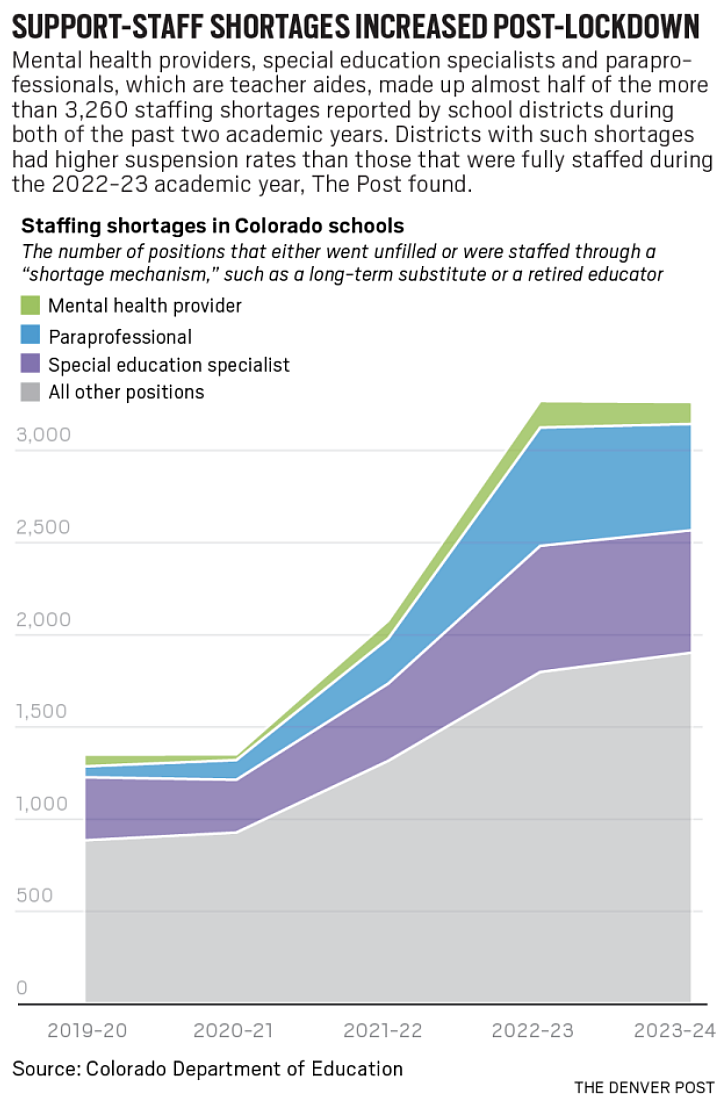
As staffing shortages made it difficult for schools to support students, it also hindered efforts to implement alternative restorative justice practices, according to educators and advocates.
“The system as a whole isn’t providing what our kids need,” Gould said.
An out-of-school suspension becomes one of the only options available to administrators when schools can’t adequately meet students’ needs and safety concerns arise, said Michelle Murphy, executive director of the Colorado Rural Schools Alliance.
“We have an absolute obligation to keep all of our kids safe,” she said.
But parents and advocates said schools further excluded children from their peers and classroom instruction post-lockdown by using out-of-school suspensions to deal with challenging behaviors, including those that stem from the trauma, stress and isolation students faced during the pandemic.
“The kids that are already behind are just going to continue to be behind and not be successful because you continue to take them out of school,” said Barbara Andrea Garza Guzman, executive director of culture, services and programs at the Transformative Justice Project of Colorado.
“We’re punishing them for being human,” she said.
Growing reliance on out-of-school suspensions
The data analyzed by The Post showed that Colorado districts turned to out-of-school suspensions more frequently after in-person learning resumed compared to less severe in-school or classroom suspensions.
Out-of-school suspensions are a more severe punishment in that they temporarily remove students from school grounds. In-school suspensions remove students from their classroom to another room in the building, where they are often supervised and given work to complete.
Statewide, school districts issued out-of-school suspensions at nearly twice the rate of in-school suspensions during the 2023-24 academic year, according to The Post’s analysis.
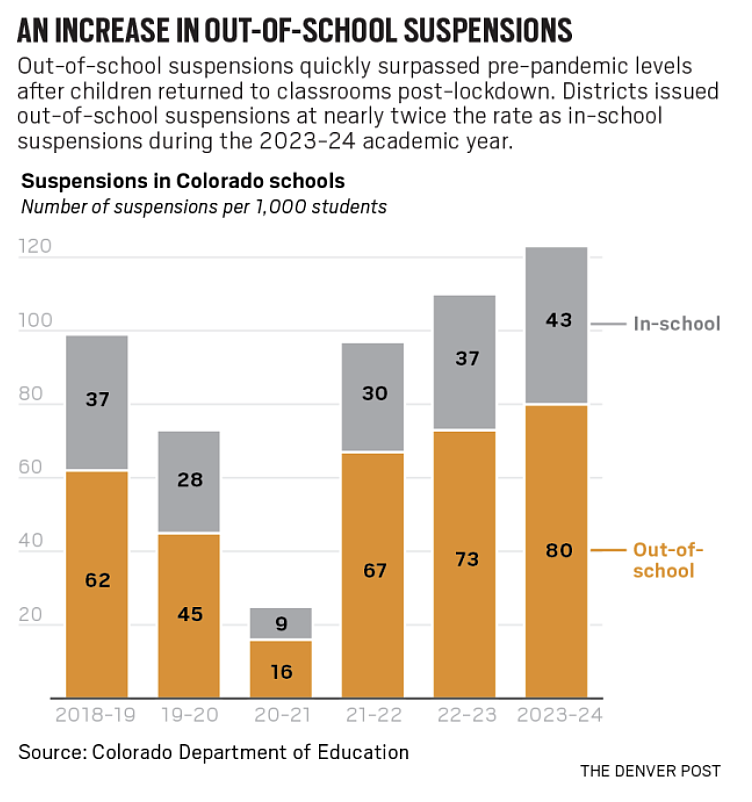
In-school suspensions rebounded after falling during remote learning, but didn’t surpass pre-pandemic levels until last year, when they climbed 16% from the 2022-23 academic year to a rate of 43 per 1,000 students, The Post found.
Districts’ growing use of out-of-school suspensions is notable because most of the punishments were issued for less severe behaviors, said Elie Zwiebel, a juvenile rights attorney and co-executive director of Transformative Justice Project of Colorado.
“The increase in out-of-school suspensions and the clear data indicating those suspensions are predominately for low-level and nonviolent issues… tells us that schools are choosing to be overly punitive by pushing students out of their classrooms instead of exploring in-school alternatives to discipline,” he said.
Even though the rate of out-of-school suspensions for serious offenses, such as assaults and weapons, increased significantly — by 40% — in the first five years examined by The Post, they were issued at a much lower rate than for less severe offenses.
Out-of-school suspensions for nonviolent offenses, including substance use and disobedience, rose 16% to a rate of 66 per 1,000 students between the 2018-19 and 2022-23 academic years — and were issued by school districts at almost 10 times the rate as those for more serious behaviors, The Post found.
By comparison, districts issued 7 out-of-school suspensions per 1,000 students for serious behaviors during the 2022-23 academic year, which was up from 5 out-of-school suspensions per 1,000 students four years earlier, according to The Post’s analysis.
Data for the 2023-24 academic year that shows why districts suspended students is not directly comparable to the previous five years because of changes made by the state education department. But it does show districts issued out-of-school suspensions for non-violent offenses at nine times the rate of more serious behaviors.
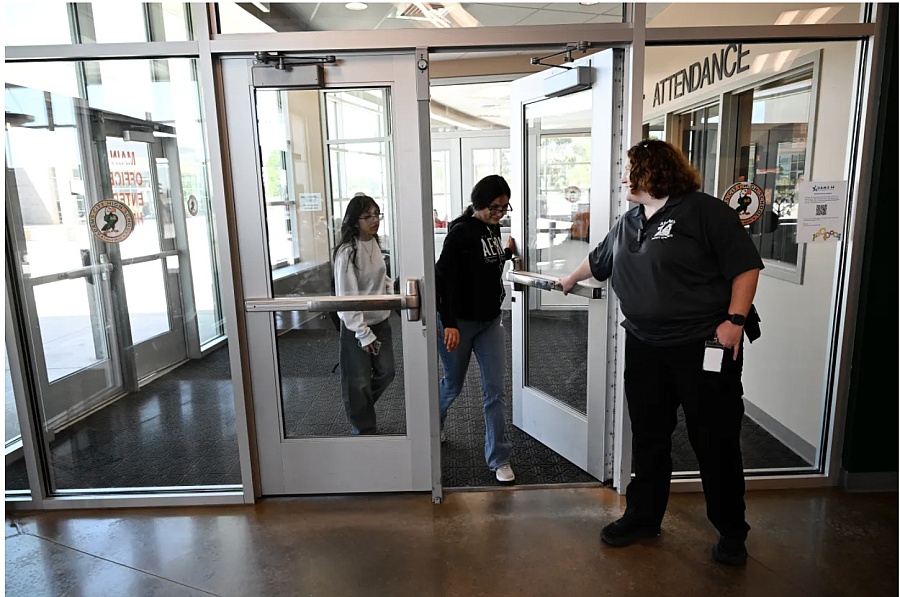
Ronnie Brickey, director of safety and security for Adams 14, smiles while letting students back inside the building after lunch break at Adams City High School in Commerce City on Aug. 27, 2024.
(Photo by Helen H. Richardson/The Denver Post)
“This is a great idea on paper”
Historically, after a major crisis, suspensions and expulsions increase, such as they did after Hurricane Katrina devastated New Orleans in 2005.
After major disruptions, educators lean into zero-tolerance policies for even minor behaviors, in part, because they themselves are stressed and burned out, said Lauren Henry, a psychologist at Children’s Hospital Colorado.
Research, including a 2021 study by the American Institutes for Research, has shown that out-of-school suspensions don’t curb misbehavior and are more likely to cause children to fall behind academically, drop out of school and be incarcerated.
In recent years, school districts nationwide moved to adopt restorative justice practices, which focus less on punishments and more on repairing relationships and accountability.
But staffing shortages made it difficult to put restorative measures in place successfully, said Berry, the principal of Eastlake High in Colorado Springs.
“When you don’t have the staffing to do alternative discipline it turns into: This is a great idea on paper,” she said.
Children were exposed to the many stressors that came from living through the pandemic. They became sick with COVID-19 and lost loved ones. They watched as their parents became unemployed and struggled to afford housing and food.
Children and teens also missed out on crucial socialization and milestones during the early years of the pandemic, such as sleepovers, sports and homecomings.
In losing these things, children also lost the opportunity to learn how to relate and connect to others, which is important in helping them develop their sense of self and their identity, said Riley Cochran, executive director and therapist at Resolute Youth Services.
For the first four years of The Post’s analysis, school districts that had any staffing shortages — whether teachers or principals — always had higher suspension rates than those that reported they were fully staffed.
But that changed during the 2022-23 academic year as the suspension rate was roughly the same between districts that were fully staffed and those with shortages — a sign that educators and advocates said reflected a deeper shift in schools.
It’s not just enough to staff a position, they said, it also matters who’s in the school and the relationships they have with students.
And when children returned to the classroom post-lockdown, something else was missing besides support staff: students’ sense of belonging.

High school students hang out in the shade with safety advocate Jorge Analla, left, during their lunch break near the outdoor basketball court at Adams City High School in Commerce City on Aug. 27, 2024. The students are, from left to right, Angel Lopez, 16, in the passenger seat, Jonathan Juarez, 15, and Sophie Lopez, 14.
(Photo by Helen H. Richardson/The Denver Post)
“Kids were raised in this stress”
Principal Karen Ikegami, who runs RiseUp Community School in Denver, thought children would be fine when they returned to school after remote learning. The amount of time kids were out of the classroom was small in comparison to how long many of them had been attending school, she recalled thinking.
But, Ikegami said, “They just weren’t.”
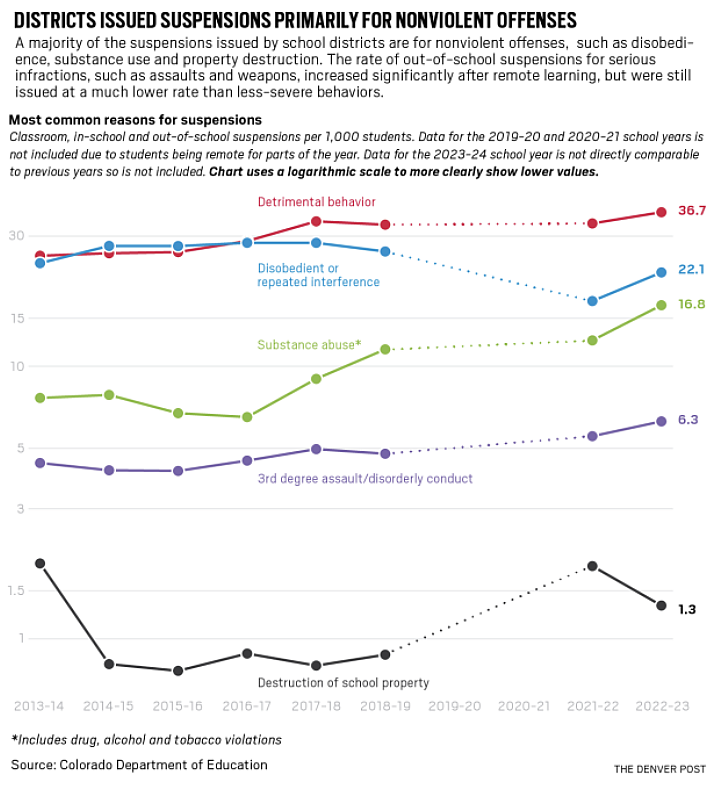
District officials, school administrators and teachers across the state told The Post they noticed a change in children’s behavior after they returned to the classroom. They said it’s harder to engage children in lessons and with each other.
A child’s behavior is also more likely to escalate, meaning conflict between students can more easily turn into a fight compared to before the pandemic, educators said.
“Students’ ability to cope in large settings has changed a lot,” Ikegami said. “…They’re in these really high-pressure situations to learn and talk with their peers and I just think they’re a little bit not as used to it after the pandemic.”
When children are overwhelmed they are more likely to engage in behaviors that allow them to escape distress, such as fleeing classrooms, shouting or destroying school property, said Henry, the Children’s Hospital psychologist.
Children and teens have acknowledged the challenges they faced when they returned to the classroom. They felt behind academically and found it harder to stay seated in class for long periods. They had to adjust to using pencils and paper again after relying only on computers for so long.
Axel Cano, 15, said he noticed that when in-person learning resumed some of his classmates didn’t really talk. Others, he said, spoke too much.
“It felt like coming back, kids didn’t know how to act together,” said Axel, a sophomore at Denver’s North High School.
Joey, the teen in Denver, was a sixth-grader when COVID-19 closed schools in March 2020. Since then, his life has changed. His relationships with family members became strained and his grades slipped during remote learning.

Joey, a Denver Public Schools student, participates in the Healing Words Open Mic event with the Huitzilin Warriors group at La Raza Park in Denver on June 21, 2024.
(Photo by Zachary Spindler-Krage/The Denver Post)
When Joey returned to the classroom in 2021, he encountered a parade of new teachers. His English class at STRIVE Prep-Lake, a charter middle school that has since closed, cycled through three different teachers that year, Joey said. He had two different math teachers as well, including one who Joey said taught the class from Nebraska via a screen.
Joey began using marijuana once back in school and the suspensions followed, with North High School officials sending him home at least twice, according to his discipline records.
“It was a pretty bad environment to start back from COVID,” Joey, now a junior, said. “I really didn’t learn anything from that whole year.”
DPS spokesman Scott Pribble declined to comment on any of the specific suspensions mentioned in this story, including Joey’s, citing federal student privacy laws.
The pandemic’s lingering effect on children’s social-emotional development has also appeared in Colorado’s youngest learners, those who were babies and toddlers during the height of the crisis. They were too young to be in a classroom during lockdown but missed out on preschool and other socialization, while also being exposed to their parents’ stress.
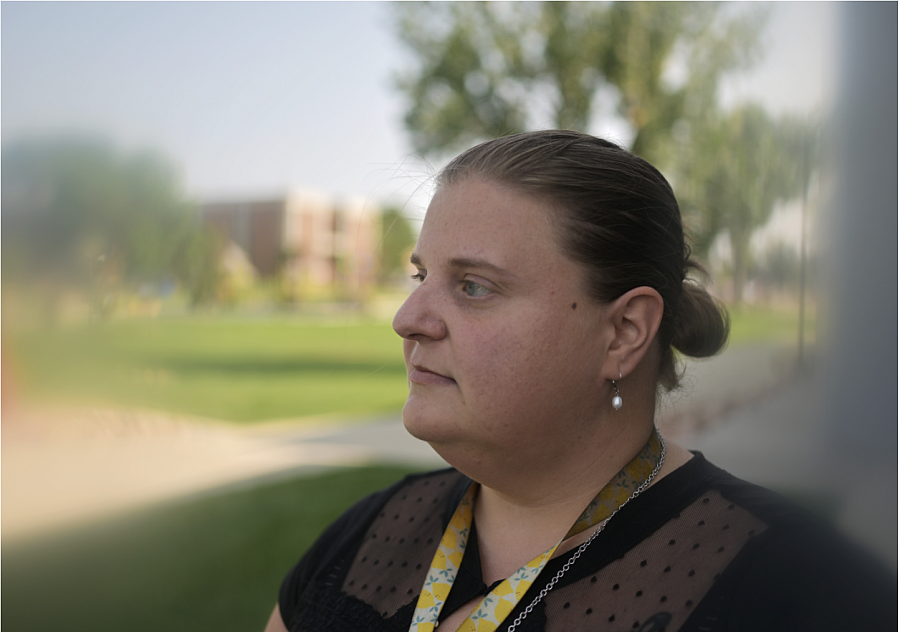
Kathryn Quinn, a former Adams 14 teacher, near the school where she used to work in Commerce City on July 25, 2024.
(Photo by RJ Sangosti/The Denver Post)
In Kathryn Quinn’s kindergarten classroom, 5-year-olds show signs of anxiety, often in the form of headaches.
“Kids were raised in this stress that they can’t escape from so they are kind of stewed in it,” said Quinn, who taught in Adams County School District 14 in Commerce City until last year.
Kelley Layton has noticed more of her fourth- and fifth-grade students at Metropolitan Arts Academy in the Westminster Public Schools district are struggling with perfectionism and don’t handle it well when they make a mistake in class. Children also have shorter attention spans, so they need more of what Layton calls “brain breaks.”
Since the pandemic, Layton has started teaching her students how to talk about their emotions by using a set of “zones” that help them identify what they are feeling.

LEFT: Teacher Kelley Layton gives a lesson to fifth-grade students on how to talk about their emotions by using a set of “zones” that help them identify what they are feeling, during class at Metropolitan Arts Academy in Westminster on Sept. 4, 2024. RIGHT: Zechariah Jackson, 10, works on an activity related to the emotional learning “zones.”
(Photos by Hyoung Chang/The Denver Post)
If a child is in the “green zone,” they are happy and able to complete their school work. If they are in the yellow zone, the student is feeling anxious or frustrated — or, in other words, they aren’t focused and in a place to learn. Once a student reaches the red zone, they are too angry and upset, Layton said.
By teaching the zones to children, they learn how to verbalize what they are feeling so that once they start reaching the “yellow” zone, both Layton and the student know the kid needs a break.
“Education — it’s like going up steps,” Layton said. “…We’re just constantly trying to catch them up and students know this.”
“They’re sending home elementary school kids”
The increase in out-of-school suspensions post-lockdown appeared in districts both in metro Denver and Colorado’s rural communities, The Post found.
However, districts in the metro area had a 21% higher out-of-school suspension rate — 68 per 1,000 students — than their rural counterparts during the 2022-23 academic year. That same year, districts in metro Denver also had more than twice the number of staffing shortages when it comes to special education specialists, paraprofessionals and mental health providers, The Post found.
(The Colorado Department of Education redacted discipline data for 25 rural districts for student-privacy reasons in the 2023-24 school year, so The Post was unable to compare metro and rural districts for that period.)
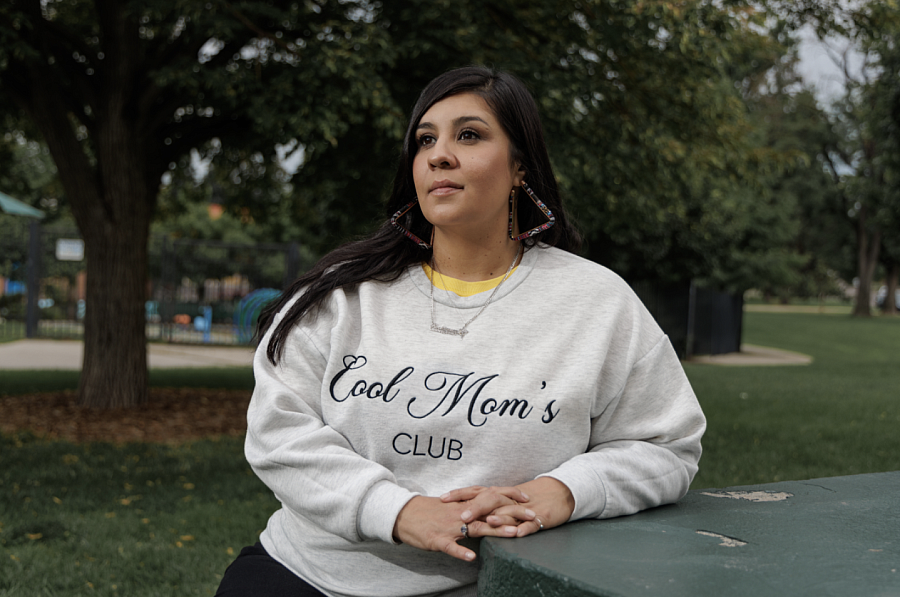
Denver parent Moriah Rodriguez at Barnum Park in Denver on Friday, Aug. 9, 2024. She has two sons with disabilities who have been suspended from school.
(Photo by Amanda Lopez/Special to The Denver Post)
Moriah Rodriguez, who lives in Denver, has watched staffing shortages affect her two sons, who both have intellectual disabilities and have received multiple suspensions before and since the pandemic.
If someone, such as a substitute teacher, isn’t familiar with the behaviors that can stem from Rodriguez’s sons’ disabilities, the boys can appear defiant, she said. (The Post isn’t identifying Rodriguez’s sons to protect their privacy.)
Rodriguez’s eldest son, a 19-year-old senior at a DPS school, is supposed to have a paraprofessional with him daily, she said.
A paraprofessional can help Rodriguez’s son with his school work, which he struggles with because of his disabilities. But getting an aide has become harder since the pandemic, she said.
And without the support, Rodriguez said, her son is more likely to walk out of class without permission — which led DPS school officials to suspend him during the 2022-23 academic year, according to his discipline records.
“They’re not getting the support they should be getting,” Rodriguez said, adding, “It doesn’t feel like how school should feel.”
Quinn, the kindergarten teacher, experienced a similar situation with a student in her classroom in Adams 14 last year.
The child, who had disabilities, was supposed to have a one-on-one paraprofessional in the classroom to help him with his work, she said.
But the school didn’t always provide an aide because of staffing shortages and the child fled the classroom multiple times because he struggled in class, said Quinn, who now works at Marrama Elementary School in Denver.
At least once, school administrators responded by suspending the kindergartener, she said.
“It’s something they wouldn’t have been suspended for if they would have had their ‘para’ there,” Quinn said. “…They’re sending home elementary school kids mostly because they don’t have behavioral plans in place.”
Adams 14 had the highest out-of-school suspension rate — 241 per 1,000 pupils — in metro Denver despite being the third smallest district, with 5,484 students during the 2023-24 academic year.
Michael Abdale, Adams 14’s director of schools, acknowledged the high rate of suspensions, saying the district started restorative justice training for employees and is hiring safety advocates for its middle and high schools. Those employees’ main job will be to connect with students and become trusted adults in the building.
“When we first came back to school, generally speaking, we were all predicting the education gaps would be there,” Abdale said. “The social-emotional gap, I think, was bigger.”
Adams 14 reported seven paraprofessional shortages last school year, an improvement from the 21 shortages the district had in 2022-23, state data shows.
But even when districts are able to fill positions, it’s not always enough to keep a child in school.
Chelsey Kerf, a paraprofessional who worked with Quinn last year, said that when she couldn’t make it to work, administrators either sent students home early or told parents to keep their children from school that day.
Their reason: The school didn’t have enough support, she said.

